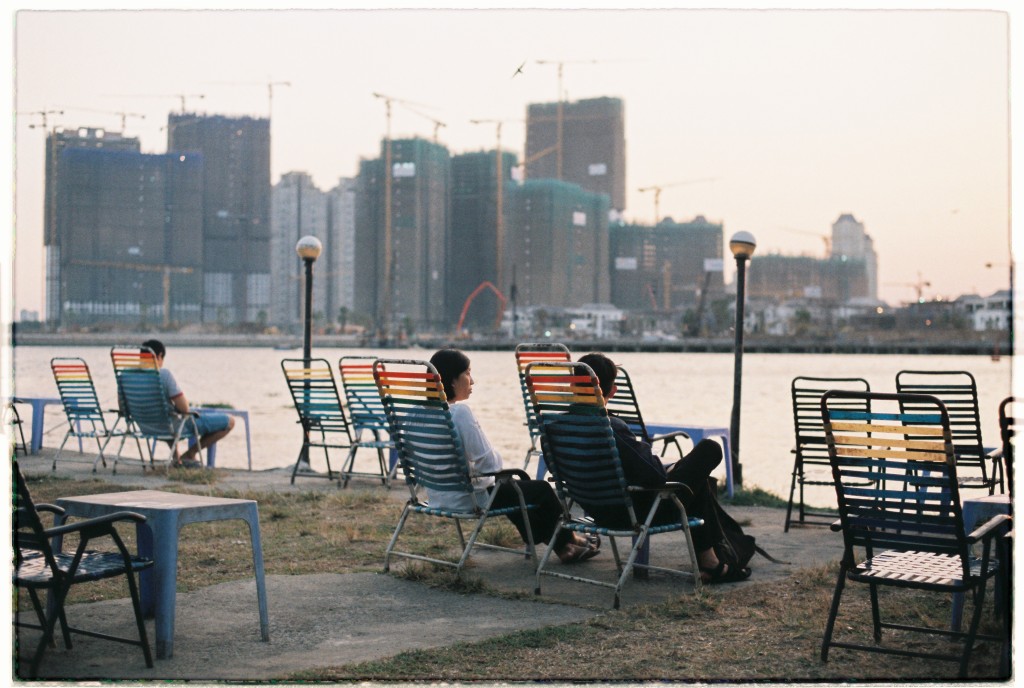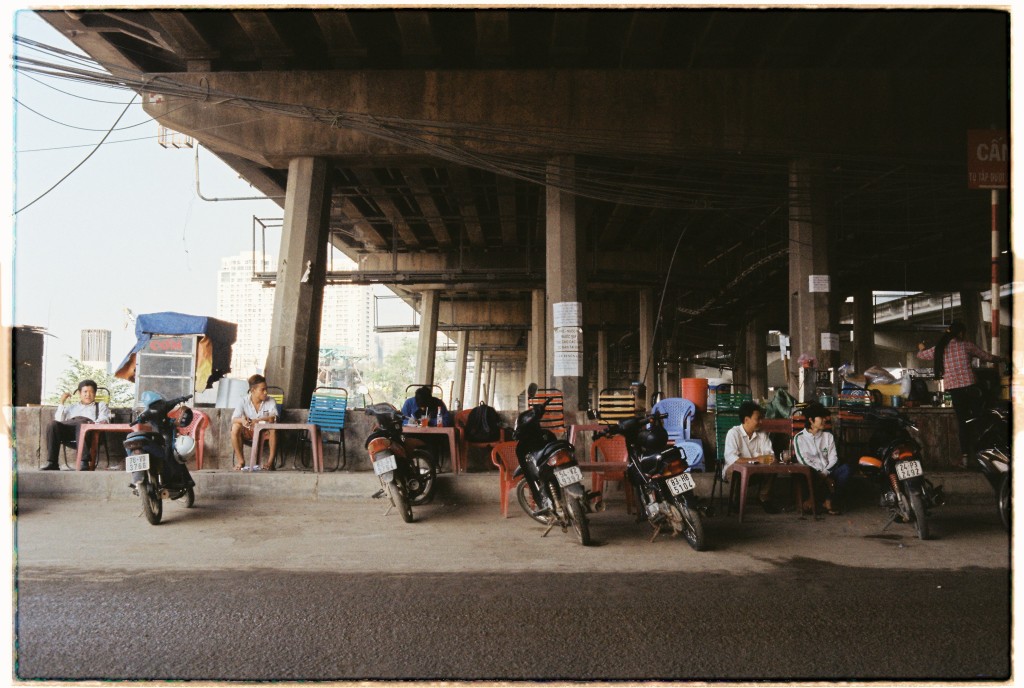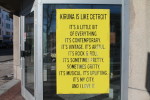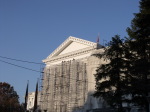by Lily Pugh
Any observer of cities will tell you that no city is a fixed or complete entity but few cities are in such a fluid state of transformation as Ho Chi Minh City today. Since 1986 Vietnam has been undergoing a period of economic reform known as ‘Doi Moi’ towards a socially oriented market economy. Vietnam’s economic centre Ho Chi Minh City is being uprooted and transformed. Billboards broadcast visions of the future city that is incrementally but rapidly materializing. It is hard to think of an image of the city today beyond it’s soon to be past and present.
Café on the banks of the Saigon River, Street 21, Binh An Ward, District 2, HCMC

Café on the banks of the Saigon River, Street 21, Binh An Ward, District 2, HCMC
This makeshift cafe on the banks of the Saigon River is a popular spot for young couples, positioned next to a collection of ‘Love Hotels.’ At night the city lights reflect off the peaceful water but like most spots in the city the view is overwhelmed by a huge construction site.
The view from Luong Dinh Cua, Thu Thiem, HCMC

The view from Luong Dinh Cua, Thu Thiem, HCMC
There is a famous ‘before and after’ image of Shanghai from 1990 and 2010 used often to demonstrate the incredible rapidity of Shanghai’s development. Ho Chi Minh City today looks like the before picture. There are comparisons to be made with the area of Pudong, that now has some of the tallest buildings in China and Thu Thiem the site on which HCMC’s brand new city center will be built. Thu Thiem is a 657 hectare peninsula of undeveloped land across the Saigon river from District 1, the current central historical and financial district. It is a blank slate on which the image of 21st Century Vietnam will be constructed.
The view from Tran Van Khe, Thu Thiem, HCMC

The view from Tran Van Khe, Thu Thiem, HCMC
This is one of the wide roads connecting the Thu Thiem with the historical district across the river. One such road will form an an axis from the heart of Thu Thiem to the colossal nine hundred meter pedestrian street Nguyen Hue over the river, at the base of which stands a statue of Ho Chi Minh and the People’s Committee Building (the former French colonial town hall), linking the old with the new. The design for Thu Thiem is consciously symbolic, crafting a narrative in the urban space that communicates Vietnams departure from the past and describes its global present-ness. It is also iconic, giving the city a recognizable image on the international stage. Positioned across the river, Thu Thiem has many effective vantage points to be viewed and photographed from, whilst reaching new heights it also carves out a new skyline to be viewed from a distance. The power and centrality of the financial district will be clear and create a physical and cultural sense of destination for those on the urban fringes.
Billboard on Nguyen Huu with Saigon Riverside apartments behind Canh, Binh Thanh District, HCMC

Billboard on Nguyen Huu with Saigon Riverside apartments behind
Canh, Binh Thanh District, HCMC
On the billboard is an advertisement for VinHomes Central Park, a spectacular luxury housing development. With extensive green areas, a hospital, international school, mall and waterpark, it is, as the billboard states ‘The symbol of the prosperity of the new era.’ The patina green skyscraper rising through the top of the building recalls the statue of liberty whilst the name is a direct reference to Central Park, New York City (as stated in advertisement material). Many of the new luxury building complexes have English names, symptomatic of the complex relationship between modernity, westernization, americanisation and globalization. Whilst nothing about the site strives to be specifically American or ‘Western’, the idea of New York is used to evoke cosmopolitanism and some form of authentic ‘cultural’ urbanity. Songdu, a whole new ‘smart city’ built outside of Soeul in South Korea also has a Central Park imitation that is similarly unlike the original Central Park in Manhattan.
A streetseller serves construction workers near the site of the new VinHomes Central Park Construction Site.

A streetseller serves construction workers near the site of the new VinHomes Central Park Construction Site.
These luxurious sites are worlds away from the ‘informal economy’ that characterizes the street and proliferates throughout the city; where every family runs a business from their living rooms, people circulate neighborhoods on their bikes offering services and makeshift street food stalls and café’s produce variety of foods. The street produces heterogeneity, spontaneity and community in the experience of the city. Contrastingly these new cities are meticulously and wholly planned and will have no space for improvised businesswomen like this one.
View from Nguyen Van Linh, District 7, HCMC

View from Nguyen Van Linh, District 7, HCMC
District 7 is built on reclaimed swampland and was a major project of the 1990’s, that has been deemed a great success (with only a few critics pointing out the divisive quality of gated communities). District 7 is an effective forecast for the kind of city to be built developed in future years. It is characterized by huge empty shopping malls, chain restaurants, supermarkets and wide, clean, empty streets. This image of a city is not an unfamiliar one. Ho Chi Minh is undergoing a process of globalization we are familiar with as it begins to construct spaces that resemble those of any major city. Yet for many aspirant Vietnamese these somewhat clinical but clean, ordered sites are very desirable. Living in a towerblock allows a removal from the noise, pollution, rats, cockroaches, ants, sweltering heat and enhances security, not to mention status. Beyond this, the allure of what we might call ‘modernist’ aesthetic is a powerful one.
Sunrise City, 23- 25- 27 Nguyen Huu Tho, Than Hung Ward, District 7, HCMC

Sunrise City, 23- 25- 27 Nguyen Huu Tho, Than Hung Ward, District 7, HCMC
Sunrise City is a huge construction project made up of six towers 2,200 apartments, offices and commercial spaces. It is already an imposing structure amidst nearby less affluent neighbourhoods. So far, in Ho Chi Minh City development means starting from scratch opposed to working with the existing urban fabric. This tendency is being seen increasingly in the developing world, in part because the mass migration to cities has created a demand for large scale new constructions. However it is also telling of how ‘modernisation’ is seen as a departure from national or local histories and a new moment of origin.
Billboard on the side of a ‘tube’ house. The view from Kenh Te Bridge, District 4, HCMC

Billboard on the side of a ‘tube’ house. The view from Kenh Te Bridge, District 4, HCMC
It is not just the super wealthy who are moving into this new style of living. On this billboard there is an image of similar style apartments priced at 1.28 billion VND, around 50,000 USD and an affordable price for many Vietnamese.
The popularity of this style of apartment marks a departure from the tradition of multiple generations living under one roof. The building onto which the billboard is fixed is an example of the distinctive ‘tube’ houses that are common in Vietnam today. They are a unique product of the unusual policy where houses were taxed by the width of the building against the street) and also describe a common social structure in which a whole family lives under one roof, often with a generation on each floor. Currently many young adults are expected to live with and support their families until they have their own but these architectures facilitate a more individuated style of living. This is a clear example of the desire to move from a historically and socially specific architecture to a ‘global’ one.
Motorbikes on Vo Van Kiet, District 1 at rush hour

Motorbikes on Vo Van Kiet, District 1 at rush hour
Public transport will be crucial to transforming the city. There are estimated to be 6 million motorbikes on the roads of Ho Chi Minh City everyday (in a city of 8 million). Despite heavy taxation there has been a 70% increase in car sales as the rising middle classes seek status and an escape from the treacherous and chaotic traffic (one person dies every hour on the road in Vietnam as reported recently in The Saigoneer). At this rate the roads will soon come to a halt. The motorbikes are emblematic of economic transition and also a potent symbol of its precarity. You will often see whole families piled onto a single motorbike and people strap anything from fridges to live fish to panes of glass onto their bikes to get them from A to B. For many it is the only way to get their kids to school or to get to work.
Construction workers take a coffee break under the new underground line running through the city, Dien Bien Phu, Binh Thanh, HCMC

Construction workers take a coffee break under the new underground line running through the city, Dien Bien Phu, Binh Thanh, HCMC
A much needed central subway line is under development with funds from Japan. Posters across the city bear the names Vietnam and Japan with both flags making public a cultural alliance. Whilst multiple lines are envisioned, only two are planned and one underway and there are rumors that it is over budget and behind schedule. It is still unknown how much travel will cost and who it will be available to.
View into a local neighbourhood from the bridge on Nguyen Huu, Binh Thanh, HCMC

View into a local neighbourhood from the bridge on Nguyen Huu, Binh Thanh, HCMC.
Similarly the overhead wires which hang heavy through the city streets are another symbol that HCMC, as it is, can not accommodate the for the changing times. Often wires wrap around houses and through streets making the landscape treacherous during the downpours of rainy season.
Lilly Pugh has an Ma in history of art from the University of Edinburgh where she specialised in visual culture. She is interested in looking at cities as aesthetic objects and tracing the social and political contexts that give them form. Pugh is particularly interested in East Asian cities and currently lives in Ho Chi Minh city, Vietnam.
Follow her at cargocollective.com/lillypugh








